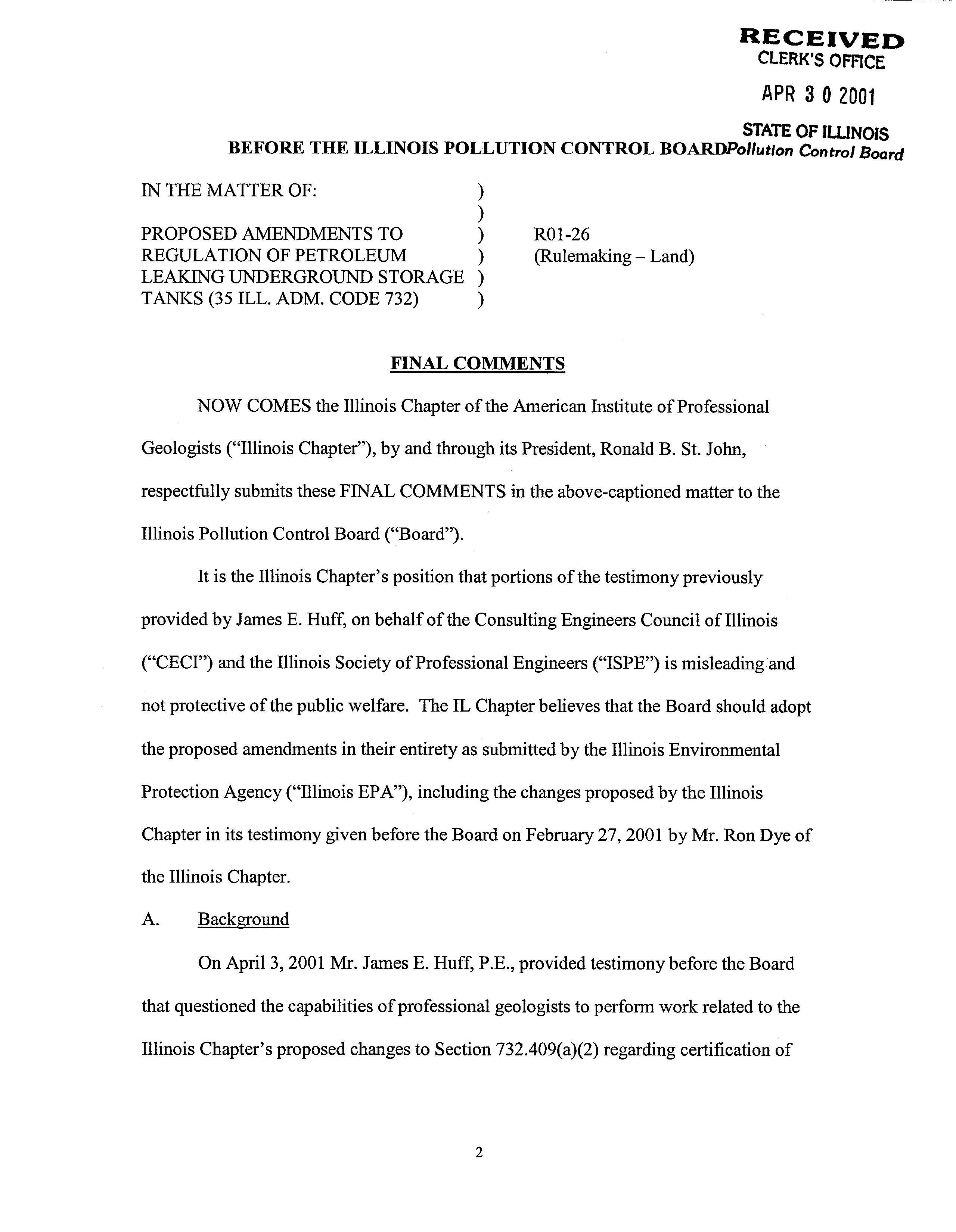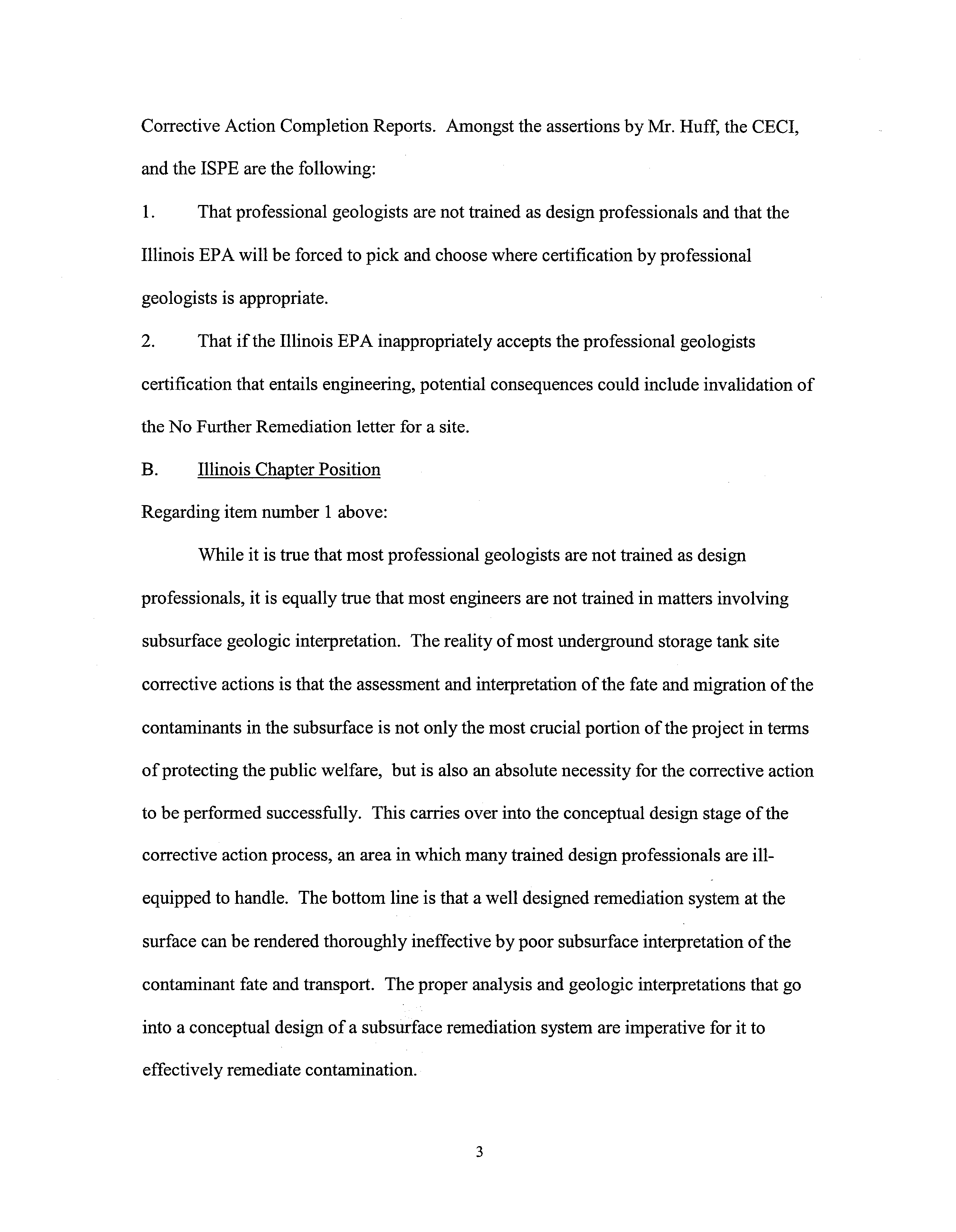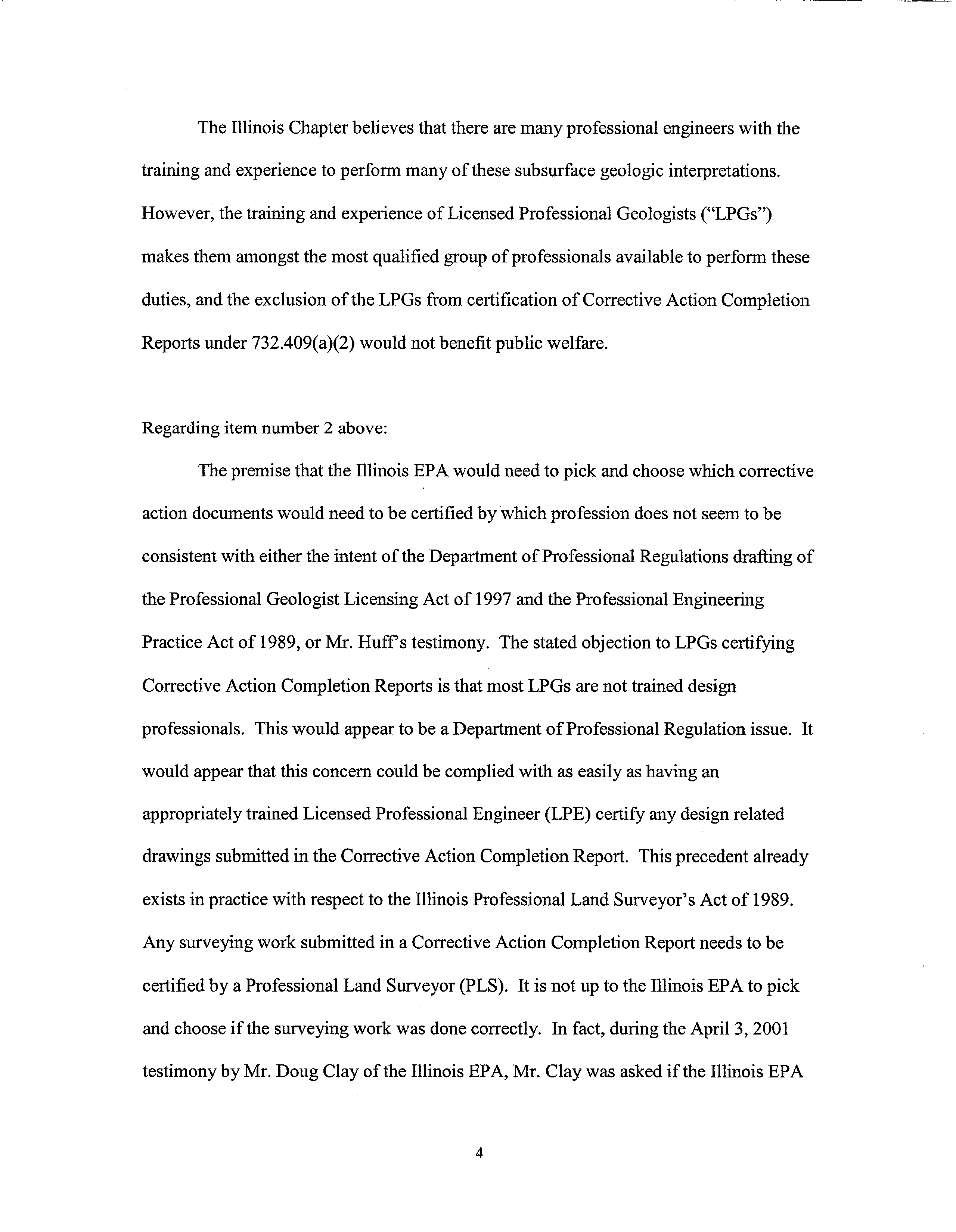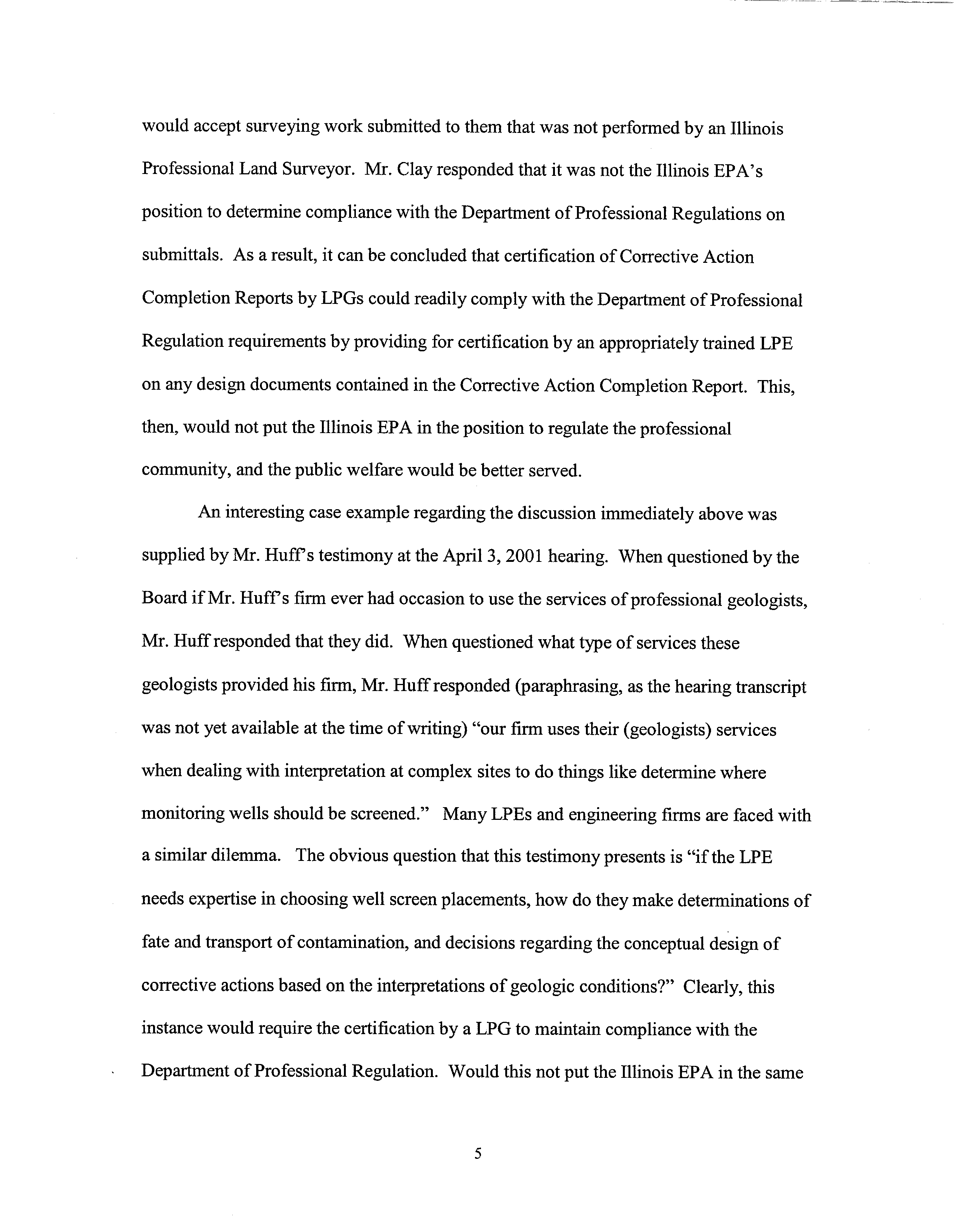JIEC~IVEJJ
CLERK’SOFFICE
APR
302001
STATE OF ILUNOIS
Polluti
0,~,
Con trotBoard
BEFORE THE ILLINOIS POLLUTION CONTROL
BOARD
IN THE MATTER OF:
)
)
PROPOSED AMENDMENTS TO
)
REGULATION OF PETROLEUM
)
LEAKING UNDERGROUND STORAGE
)
TANKS (35 ILL. ADM. CODE 732)
)
RO1-26
(Ru1emaking~~
NOTICE OF FILING
TO:
Ms. Dorothy M. Gunn
Clerk ofthe Board
Illinois Pollution Control Board
James R. Thompson Center
100 West Randolph Street
Suite 11-500
Chicago, Illinois 60601
(VIA FEDEX
-
OVERNIGHT)
Mr. Joel J. Stemstein
Hearing Officer
Illinois Pollution Control Board
James R. Thompson Center
100 West Randolph Street
Suite 11-500
Chicago, Illinois 60601
(VIA FEDEX
-
OVERNIGHT)
All Other Persons on the Attached Service List (U.S. Postal Service)
PLEASE TAKE NOTICE that today I have filed with the Office of the Clerk of
the Pollution Control Board the attached Final Comments ofthe Illinois Chapter ofthe
American Institute ofProfessional Geologists
in the above-titled matter, a copy ofwhich
are hereby served upon you.
Respectfully submitted,
ILLlNOIS CHAPTER
AMERICAN INSTITUTE OF
PROFESSIONAL GEOLOGISTS
Dated: April 27, 2001
Illinois
Chapter, AIPG
Clayton Group Services
3140 FinleyRoad
Downers Grove, Illinois
60515
(630) 795-3200
Ronald B. St.
I
RECEIVED
CLERK’5OFFICE
APR
30
2001
STATE OF ILLINOIS
BEFORE THE
ILLINOIS POLLUTION CONTROL
BOARDPoIIution ContToI Board
IN THE MATTER OF:
)
)
PROPOSED AMENDMENTS TO
)
ROl-26
REGULATION OF PETROLEUM
)
(Rulemaking
-
Land)
LEAKING UNDERGROUND STORAGE
)
TANKS (35 ILL. ADM. CODE 732)
)
FINAL
COMMENTS
NOW COMES the Illinois Chapter ofthe American Institute of Professional
Geologists (“Illinois Chapter”),by and through its President, Ronald B.
St. John,
respectfully submits these FINAL COMMENTS
in the above-captioned matter to the
Illinois Pollution Control Board (“Board”).
It is the Illinois Chapter’sposition that portions ofthe testimony previously
provided by James E. Huff, on behalf ofthe Consulting Engineers Council ofIllinois
(“CECI”) and theIllinois Society ofProfessional Engineers (“ISPE”)is misleading and
not protective ofthe public
welfare. The IL Chapter believes that the Board should adopt
the proposed amendments in their entirety as submitted by the Illinois Environmental
Protection Agency (“Illinois EPA”), including the changesproposed by the Illinois
Chapter in its testimony given before the Board on February 27, 2001
by Mr. Ron Dyeof
the Illinois
Chapter.
A. Background
On April 3, 2001
Mr. James E. Huff,
P.E., provided testimony before the Board
that questioned the capabilities ofprofessional geologists to performwork related to the
Illinois
Chapter’sproposed changes to Section 732.409(a)(2) regarding certification of
2
Corrective Action Completion Reports. Amongst the assertions by Mr. Huff, the CECI,
and the ISPE are the following:
1.
That professional geologists are not trained as design professionals and that the
Illinois EPA will be forced to pick
and choose where certification by professional
geologists is appropriate.
2.
That if the Illinois EPA inappropriately accepts the professional geologists
certificationthat
entails engineering, potential consequences could include invalidation of
the No Further Remediation letter for a site.
B.
Illinois
Chapter Position
Regarding item number 1
above:
While it is true that most professional geologists are not trained as design
professionals, it is equally true that most engineers are not trained in matters involving
subsurface geologic interpretation. The reality ofmost underground storage tank site
corrective actions is that the assessment and
interpretatkm ofthe fate and migration ofthe
contaminants in the subsurface is not only the most crucial portion ofthe project in terms
ofprotecting the public welfare,
but is also an absolute necessity for the corrective action
to be performed successfully.
This carries over into the conceptual design stage ofthe
corrective action process, an area in which many trained design professionals are ill-
equipped to handle. The bottom line
is that a well designed remediation system at the
surface can be rendered thoroughly ineffective by poor subsurface interpretation ofthe
contaminant fate and transport. The proper analysis and geologic interpretations that go
into a conceptual design of a subsurface remediation system are imperative for it to
effectively remediate contamination.
3
The Illinois Chapter believes that there are many professional engineers with the
training and
experience to perform many ofthese subsurface geologic interpretations.
However, the training and experience ofLicensed Professional Geologists (“LPGs”)
makes them amongst the most qualified group ofprofessionals available to perform these
duties, and the exclusion ofthe LPGs from certification of Corrective Action Completion
Reports under 732.409(a)(2) would not benefit public welfare.
Regardingitem number2
above:
The premise that the Illinois EPA would need to pick and choose which corrective
action documents would need to be certified by which profession does not seem to be
consistent with either the intent ofthe Department ofProfessional Regulations drafting of
the Professional Geologist Licensing Act of 1997 and the Professional Engineering
Practice Act of 1989, orMr. Huff s testimony.
The stated objection to LPGs certifying
Corrective Action Completion Reports is that most LPGs are not trained design
professionals.
This would appear to be a Department ofProfessional Regulation issue.
It
would appear that this concern could be complied with as easily as having an
appropriately trained Licensed Professional Engineer (LPE) certify any design related
drawings submitted
in the Corrective Action Completion Report. This precedent already
exists in practice with respect to the Illinois Professional Land Surveyor’s Actof 1989.
Any surveying work submitted in a Corrective Action Completion Report needs to
be
certified by a Professional Land Surveyor (PLS).
It is not up to the Illinois EPA to pick
and choose if the surveying work was done correctly.
In fact, during the April 3, 2001
testimony by Mr. Doug Clay ofthe Illinois EPA, Mr. Clay was asked if the Illinois EPA
4
would accept surveying work submitted to them that was not performed by an Illinois
Professional Land Surveyor.
Mr. Clay responded that it was not the Illinois EPA’s
position to determine compliance with the Department ofProfessional Regulations on
submittals.
As a result, it can be concluded that certification ofCorrective Action
Completion Reports by LPGs could readily comply with the Department ofProfessional
Regulation requirements by providing for certification by an appropriately trained LPE
on any design documents contained in the Corrective Action Completion Report. This,
then, would not put the Illinois EPA in the position to regulate the professional
community, and the public welfare would be better served.
An interesting case example regarding the discussion immediately above was
supplied by Mr. Huffs testimony at the April 3, 2001
hearing. When questioned by the
Board if Mr. Huff s firm ever had occasion to use the services ofprofessional geologists,
Mr. Huff responded that they did.
When questioned what type ofservices these
geologists provided his firm, Mr. Huffresponded (paraphrasing, as the hearing transcript
was not yet available at the time ofwriting) “our firm uses their (geologists) services
when dealing with interpretation at complex sites to do things like determine where
monitoring wells should be screened.”
Many LPEs and engineering firms are faced with
a similar dilemma.
The obvious question that this testimony presents is “ifthe LPE
needs expertise
in choosing well screen placements, how
do they make determinations of
fate and transport ofcontamination, and decisions regarding the conceptual design of
corrective actions based on the interpretations of geologic conditions?”
Clearly, this
instance would require the certification by a LPG to maintain compliance with the
Department ofProfessional Regulation.
Would this not put the Illinois EPA in the same
5





